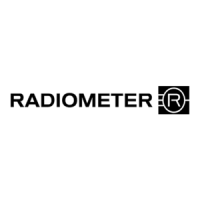
Do you have a question about the RADIOMETER ABL90 FLEX and is the answer not in the manual?
| Type | Blood Gas Analyzer |
|---|---|
| Analysis Time | 35 seconds |
| Parameters Measured | pH, pCO2, pO2 |
| Sample Volume | 65 μL |
| Connectivity | Ethernet, USB |
| Calibration | Automatic |
| Data Management | Integrated data management system |
| Sample Type | Whole blood, plasma, serum |
| Power Requirements | 100-240 V AC, 50-60 Hz, 150VA |
| Operating Temperature | 15-32 °C (59-90 °F) |
| Operating Humidity | 20-85% relative humidity, non-condensing |
Outlines significant changes and improvements in software version 2.4.
Details sensitivity and status calibration for pCO2, cGlu, and cLac.
Provides an overview of the analyzer's menu hierarchy and navigation.
Manages user access control, operators, passwords, and access profiles.
Configures measurement parameters, modes, and sample handling.
Defines automated calibration intervals and parameters for the analyzer.
Overview of the disk functions programs available for data management.
Generates a Worldwide DataCheck (WDC) file for quality control reporting.
Protects data and system files against loss through backup procedures.
Recovers all data from a backup file in case of loss or damage.
Describes the function and purpose of the analyzer's wet section.
Provides a schematic diagram of the wet section and its components.
Details the procedures for sample introduction, rinse, calibration, and QC.
Describes the analyzer's electronic modules and their functions.
Details the internal hardware components of the analyzer's electronics.
General introduction to the sensors and their role in the analyzer.
Explains the four different measuring principles used by the sensors.
Describes the calibration process for ensuring measurement accuracy.
Provides background information and construction details for the reference electrode.
Explains the purpose and application of user-defined corrections.
Defines adjustable slope and offset limits for pH and blood gas parameters.
Defines adjustable slope and offset for oximetry parameters.
Defines adjustable slope and offset for electrolyte and metabolite parameters.
Explains performance specifications achieved through method comparisons.
Defines terms like Bias, CV, Repeatability, and Reproducibility.
Describes the experimental setup and conditions used for performance tests.
Details how various substances can interfere with measurement results.
Provides an overview of parameters and their analysis.
Lists and defines all parameters measured by the analyzer.
Lists parameters that are keyed in by the operator or transferred via interface.
Lists and defines parameters calculated or estimated by the analyzer.
Provides general information about the solution pack contents and usage.
Details the calibration and quality control solutions in the pack.
Documents the traceability of parameters to primary standards.
Provides a comprehensive list of analyzer messages and troubleshooting steps.
General information about quality control and management relevant to the analyzer.
Defines statistical terms and parameters used in quality control.
Explains the definitions and usage of control ranges for manual QC.
Details the statistical rules used for evaluating quality control results.
Introduction to metrological traceability for analyzer parameters.
Details the traceability of specific parameters to primary standards.